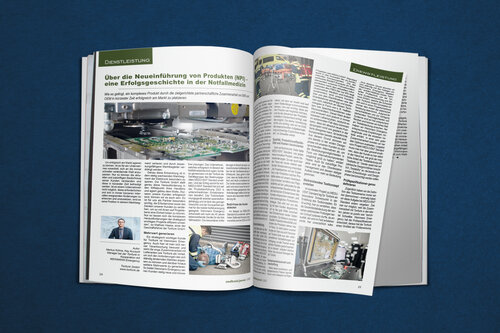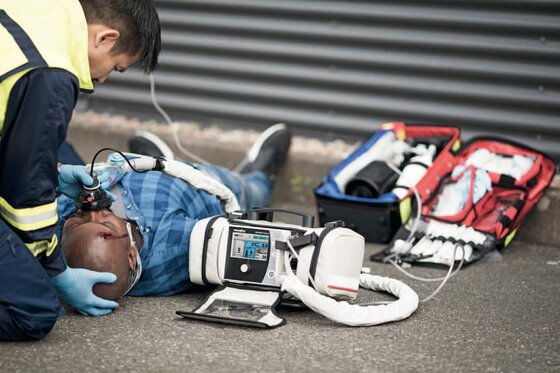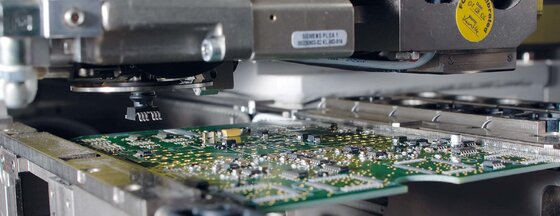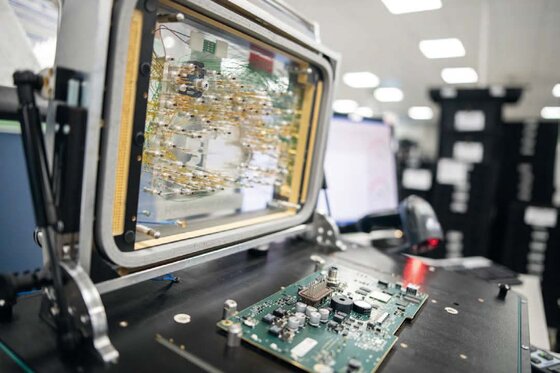In order to operate successfully in the market, it is essential for a company to adapt to the ever faster changing world. Only in this way can the current and future needs of its customers be understood and satisfied in the shortest possible time. If a company is unable to recognize and implement these necessary changes, which occur at ever shorter intervals, it will lose its position in its market segment and be displaced by more adaptable market competitors. Exactly this development is particularly noticeable in the constantly growing market segment of electronics. Tonfunk GmbH places precisely this challenge at the center of its actions and acts true to the motto "Only if our customers are successful, can we be successful as well. It is particularly important for us as a partner to understand the requirements as well as the thinking of our customers in order to be able to form a unit with them on the project level. This is the only way to efficiently implement the complex challenges of strategically important projects," says Mathias Haase, one of the managing directors of Tonfunk GmbH.
Generating added value
A strategically important customer for Tonfunk is Weinmann Emergency. Here, too, the company is aware of its responsibility and sees the close cooperation with suppliers such as Tonfunk as an advantage in order to be able to adapt to the requirements of the constantly changing market and also to generate further added value. In this way, Weinmann Emergency constantly offers its customers new and innovative solutions. The company, which operates successfully in the field of emergency medical technology, was thus able to implement the device group of the MEDUVENT Standard ventilator together with Tonfunk. And the success speaks for itself: MEDUVENT Standard has proven itself in various application scenarios since the product launch in 2020. The turbine ventilator works independently of oxygen and is optimally suited for mobile emergency care thanks to its low weight and compactness. Weinmann Emergency has been developing life-saving devices for emergency medicine for more than 45 years. The special requirements in the field of non-clinical and internal emergency medicine are the focus of device development. First and foremost, this means that the devices must be quick, easy and intuitive to operate. The devices must also be compact, robust and suitable for outdoor use. These requirements represent a particular challenge for the engineers.
Meeting the needs of the customer
The example of MEDUVENT Standard shows how important it is for EMS and OEMs to work closely together in order to achieve a product that is precisely tailored to the customer's needs. And this in ever shorter product life cycles. "In order to be able to achieve this goal right from the start, we saw ourselves as partners at eye level in every phase of the project and were also perceived as such by Weinmann Emergency. Only in this way was it possible to bundle the respective added values in the individual specialist departments on both sides, in order to be more successful as a team than the sum of each individual performance of the respective specialist departments. And it is precisely this type of cooperation that we are looking for and that drives us again and again," says Haase and adds: "If a customer places this level of trust in its partner, you have to be aware of your responsibility beyond the normal limits of an EMS service, since, for example, the Medical Device Regulation requirements have to be met in full. So you have a significant stake in the success but also the responsibility of the product. After all, this is a product in the emergency medical sector that is responsible for life and limb."
Sensible division of labour
"Our devices are designed to help rescue workers save lives," explains Billy Schwalbe, electronics developer at Weinmann Emergency. Among other things, Tonfunk GmbH supported Weinmann Emergency in the production of the circuit board for MEDUVENT Standard. "We provided the design, Tonfunk GmbH did the procurement, manufacturing and testing. It is enormously important for us to have a partner at our side with whom we can communicate directly and on the same wavelength. It was important for us to be able to accompany the process closely, and since the acceptance of the production chain takes place in Germany, this was possible. The strong networking is important for us because it enables us to achieve high-quality results despite the demanding task," Schwalbe continues.
Balancing quality, production flexibility and costs.
On the technical side, MEDUVENT Standard, like any new innovative product, also had its challenges. For example, the trend of ever-increasing miniaturization was also apparent here. "As a project partner with expertise in the production of such products, we see our responsibility in the best balance between the space required on the PCB for the corresponding components, which must meet the customer's technical requirements, and the best possible production strategy. We constantly coordinate this with the customer in order to achieve the best balance between the requirements of both sides. The balance between quality, production flexibility and cost of the product are the focus here. Thus, a team of eight people on the Tonfunk side from the various specialist departments is available to each of our customers in order to be able to deal with all topics of such a project in a targeted manner", explains Markus Kühne, Key Account Manager at Tonfunk.
Component selection and procurement
In addition to these production and design-related topics, the focus in such strategically important projects as MEDUVENT Standard is also on the selection of the components to be fitted. "Since Europe's worldwide demand for components in our focus customer portfolio is only 8% according to the latest information from FBDi (automotive, medical and industrial combined), our customers here are dependent on market drivers such as mobile telephony and naturally make use of these technologies in the form of, for example, semiconductors such as memory chips or microcontrollers. However, this market is changing and renewing itself in ever shorter life cycles, which means that in the worst case scenario, an absolutely new customer project cannot go into series production as planned because certain components are already obsolete. For this reason, we coordinate with our customers on appropriate alternatives as early as the initial design phase in order to keep the placement options in the form of alternative components as large as possible," explains Haase. Obsolescence management and its constant expansion will thus also become increasingly important for future projects.
Creating a far-reaching test concept
In the specific MEDUVENT Standard project, Tonfunk placed particular emphasis on the creation of the test concept. It is important to understand here that the overall test coverage of the individual electrical tests could not allow any slippage, as a failure that would only occur in the field would be unforgivable here. "For this reason, we constantly coordinated in detail with our colleagues from Weinmann Emergency," explains Mathias Gester, Team Leader Test Engineering from Tonfunk Systementwicklung und Service GmbH, which forms the sister company of Tonfunk GmbH Ermsleben and always takes on the electrical stimulation portion of a project implementation. "Due to the various test options and systems available to us, we are correspondingly flexible here and can achieve a high degree of test coverage. Here we have explained Weinmann Emergency corresponding recommendations, backgrounds and the individual advantages. In a very good cooperation we were able to work out the optimum here. Detached from the MEDUVENT Standard project, however, it must generally be mentioned here that the customer has it in his own hands here how large the possible proportion of test coverage and test depth is." Gester alludes here to numerous design guidelines regarding "testability" that should be taken into account in the initial development and design phase.
Define test specifications precisely
"Actually, we have always taken on the definition of the test scenario ourselves - for the first time, we have outsourced this task with MEDUVENT Standard. This was only possible because the cooperation with Tonfunk has been so positive in recent years," reports Schwalbe. Weinmann Emergency developed the test specifications, from which Tonfunk created a large part of the test instructions. When the EMS develops the test sequence, this saves time and capacity on the OEM's side. "Tonfunk supplied us with optimally coordinated sequences and we had considerably less work as a result." Sequence optimizations are particularly time-consuming and in an industry like medical technology, the goal of test coverage is 100%. Patient safety is paramount and therefore functionality is tested multiple times. In total, three different tests are carried out for MEDUVENT Standard PCBs: In addition to the ICT (in-circuit test) including boundary scan test, the comprehensive functional test is carried out via a separate PCB test bench. Here, even complex functions are tested, such as the control of the turbine in MEDUVENT Standard. In addition, an automatic optical inspection is carried out. In addition to the intensive testing at Tonfunk, final testing of each individual device also takes place in Weinmann Emergency production.
The challenge of miniaturization
For the future, Tonfunk sees ever shorter life cycles and increasingly frequent and imperative faster product qualifications as one of the emerging challenges. "If you look at this development and here, for example, only the further trend of miniaturisation, you realise that as a company you have to manage not only to adapt, but also to develop further in order to still be able to offer the customer this added value beyond the normal level. From various current projects, which we are currently bringing into series production with a wide variety of customers, I can see here that, for example, tolerance ranges in the area of PCBs or components can have a significant influence on the quality of the end product, even though these components are within their specified tolerances according to the IPC," says Kühne. He would like to see a corresponding re-evaluation of these recommended limit values with regard to the available package shapes, in order to be able to meet the trend towards miniaturization more efficiently and thus more quickly.
Ever faster iteration loops
"Ever new customer or market requirements arising for our customers from new market fields or available technologies will also promote this trend of ever faster iteration loops. In addition, we are aware that as an EMS we are operating in a market that is increasingly tending towards Eastern Europe or Asia for certain product groups. We counter this fact with the all-round package for our customers "From the idea to success on the market" and the further orientation towards highly complex, as well as highly integrated assemblies and complete systems, which require a corresponding degree of manufacturing breadth and technology", adds Haase. The growth of Tonfunk and its now almost 500 employees, which even before the Corona crisis was able to record a double-digit percentage increase in turnover every year, shows that this calculation is working. Tonfunk was also able to meet the corona-related economic challenges of 2020 well compared to its competitors thanks to its high proportion of strong and efficient medical customers such as Weinmann Emergency.





